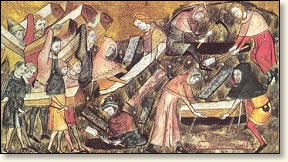"The plight of the lower and most of the middle classes was even more pitiful to behold. Most of them remained in their houses, either through poverty or in hopes of safety, and fell sick by thousands. Since they received no care and attention, almost all of them died. Many ended their lives in the streets both at night and during the day; and many others who died in their houses were only known to be dead because the neighbours smelled their decaying bodies. Dead bodies filled every corner. Most of them were treated in the same manner by the survivors, who were more
 |
Citizens of Tournai bury plague victims. These are
fortunate to have coffins. Most victims
were interred in mass graves
|
concerned to get rid of their rotting bodies than moved by charity towards the dead. With the aid of porters, if they could get them, they carried the bodies out of the houses and laid them at the door; where every morning quantities of the dead might be seen. They then were laid on biers or, as these were often lacking, on tables.Such was the multitude of corpses brought to the churches every day and almost every hour that there was not enough consecrated ground to give them burial, especially since they wanted to bury each person in the family grave, according to the old custom. Although the cemeteries were full they were forced to dig huge trenches, where they buried the bodies by hundreds. Here they stowed them away like bales in the hold of a ship and covered them with a little earth, until the whole trench was full."
References:
Boccaccio, Giovanni, The Decameron vol. I (translated by Richard Aldington illustrated by Jean de Bosschere) (1930); Gottfried, Robert, The Black Death (1983).


No comments:
Post a Comment